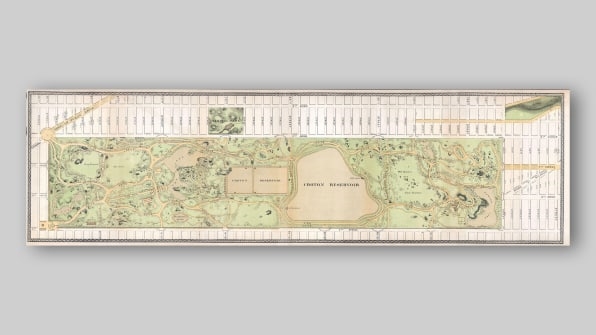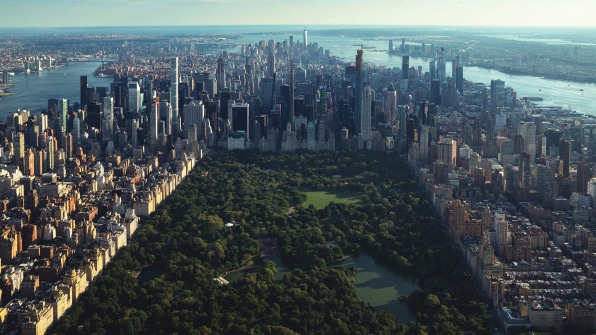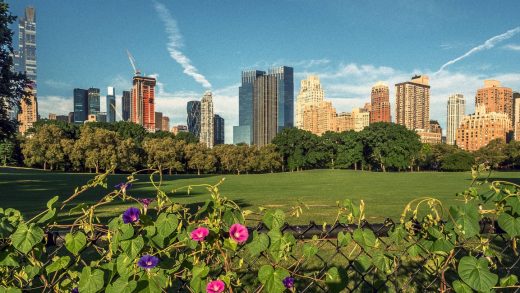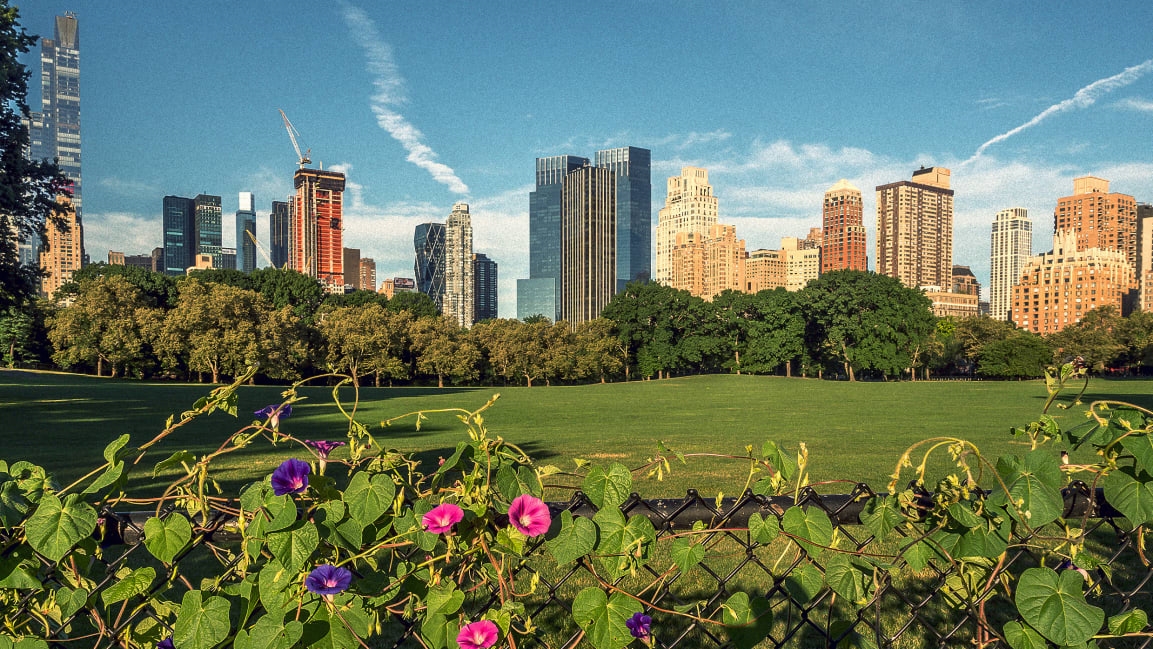What if Central Park were home to a massive urban farm?
In 1825, downtown New York City was growing crowded. Then, as now, racism made New York an uncomfortable place for Black Americans, so Andrew Williams, a Black shoeshiner, took an opportunity to move north, away from the hubub of lower Manhattan. For $125 he bought three parcels of land between what is now West 85th Street and 86th Street and where once there was just farmland. Shortly thereafter, a church bought up a plot with plans to create a cemetery for African Americans. Other Black Americans soon followed.
That was the beginning of a neighborhood called Seneca Village. Residents there, like Williams, were largely laborers. But land ownership provided an opportunity for upward mobility and Black landowners with property worth $250 or more could vote in elections. By 1850, there was a school, three churches, gardens, livestock, some 50 homes, and roughly 225 residents, the majority of whom were Black.
But the New York Williams had tried to escape was growing too: The city doubled in population between 1845 and 1855, and citizens began clamoring for green space to be set aside for recreation. Though several sites were up for consideration, including a tract of private land along the East River, the city decided on a large swath at the center of the island. Though the media of the time painted the region as a largely empty save for some poor squatters, Seneca Village fell right inside its bounds.

[Image: Wiki Commons]
The city acquired the land through eminent domain, paying owners “just compensation,” (though letters from the time reveal that Seneca Village residents did not always feel the compensation was actually fair). Seneca Village was razed and subsumed into what is now Central Park. Amber Tamm, a farmer for a nearly six-acre New York rooftop farm called Brooklyn Grange, wants to give part of the park back to that history, by taking 14 acres of the 55-acre Great Lawn and turning it into a community farm that would feed under-resourced Manhattanites, many of whom are Black. It would also serve as an educational resource for teaching New Yorkers about urban farming. Tamm wants to call it Seneca Village Farm. “I think calling out Central Park is powerful, because it’s the biggest park in New York City and it has the most flatland,” she says.
Tamm is hoping to reclaim Central Park’s narrative and make it a more inclusive one. Her vision is that one person would farm an acre each and people would apply for one of the 14 spots. Tamm envisions running a training program where she and a small team would teach people how to farm their acre with room for creative innovation. If there is someone interested in herbalism, Tamm says she would find a mentor to teach her how to grow herbs. “But also what does it look like for her to exercise creativity? Does she want to grow in rows? Does she want to grow in circles and spirals? Let her flesh out what her vision is and let her work through what it’s like to revitalize soil while also supporting community through what she yields,” says Tamm. Another example she gives: What would it look like to grow rice in New York City?
Tamm’s introduction to the existence of Seneca Village started young and was driven by her mother’s persistent interest in the village. In 1993, a book about Central Park, The Park and the People: A History of Central Park, spurred archeologists Nan Rothschild and Diana diZerega Wall, a professor at City College, to consider Seneca Village’s old plot as the site of an archeological dig. Seventeen years later, the city approved it. The excavation yielded a small glimpse into a place that captivated certain New Yorkers.

“There would be these excavations where they were finding bones of our ancestors and my mother would always be moved to tears and be investigating how she can go see it, how she can go experience it on her own,” says Amber Tamm, a farmer for Brooklyn Grange, who grew up in East New York. She says her family has lived in Brooklyn for four generations. “Once Seneca Village became a thing and once they started to find the walls and the teapots, she was deeply invested in talking about it.“
The Seneca Village Farm idea was born out of COVID-19. In the early days, food was constrained. Tamm remembers going to the farmers’ market and seeing a bleak array of produce stalls. She and a friend who works on the rooftop garden at Cooper Union, began a conversation about what it would look like for New York City to have food sovereignty or sustainable access to healthy, culturally appropriate food grown locally. What kind of food a person can access in New York City depends largely on where they live: Some neighborhoods have big grocery stores with expensive produce trucked in from all over the country. Others have corner stores with selections of packaged goods and small produce sections.
The unequal food distribution in New York has led some food activists to start urban farms that cater to individual communities. East New York Farms, for example, operates a plot and sells to local residents in the Brooklyn neighborhood. The group has also helped others to start their own community-led farms, like the one at the Louis Heaton Pink Houses, a New York City Housing Authority project in Brooklyn.
During the pandemic, food access, at least initially, was even more constrained for those who already have difficulty accessing fresh food. Soup kitchens and groups like Harlem Grown, which uses abandon lots to set up urban farms, stepped in to fill the food void with fresh vegetables and prepared meals. Tamm wonders what such efforts would be like with a bigger piece of land.
The pandemic also provided Tamm with a precedent for converting Central Park to more essential uses: Within the first three weeks of the pandemic, after New York City shut down normal operations, field tents with 68 hospital beds went up in Central Park to support Mt. Sinai hospital as it treated COVID-19 patients. Tamm says, if New York City is willing to set aside land for treating sick New Yorkers, why would it not set aside that same land for ensuring that city residents have access to good nutrition.
“Farmers and doctors are deemed essential workers. So why couldn’t we have the juxtaposition of on one side of the park they have the COVID hospital and on the other side they have farms, because that would be tackling both sides of health,” she says.
Sam Biederman, systems commissioner for community outreach and partnership development at New York City Parks, works closely with the Central Park Conservancy and also with New York City’s Green Thumb community gardens. He says that given the size of New York City’s population there is physically not enough available land in New York City to grow enough food to feed all its residents. However, he does think community gardens contribute more quality food to certain neighborhoods. Unfortunately, he says, the Central Park Conservancy, in partnership with the city, manages the park with strict rules that may make such a project difficult to undertake.
The Central Park Conservancy is a nonprofit that was founded in 1980 after the park had suffered years of decline, to rejuvenate and manage the park. The city pays about a tenth of the conservancy’s annual $85 million budget, and conservancy raises the rest through private sources. The organization works in tandem with the parks department.
“The undergirding philosophical approach is as much land should be available to all people,” says Biederman. He says that using Central Park as anything other than purely recreational space requires event permitting. The Great Lawn in particular has a lot of limits, he says, because any time an event takes over that space, it is taking it offline for recreational use. The longest a person can get a permit for the Great Lawn is two days and there are only seven permits given out a year. “Turning a significant amount of that space over to agriculture that’s a significantly different use—it’s a tall order.”
However, he also notes that the Central Park Conservancy is very aware of Seneca Village’s history and is trying to honor its legacy in various ways. Last year, the organization put up a temporary installation that highlights the work archeologists have done and their learnings about Seneca Village in the time they’ve been investigating it. It also released a series of materials that help guide teachers who want to use the exhibit to teach students about Seneca Village. Biederman says NYC Parks is also looking into renaming other parks to honor New York’s Black history. “Negotiating what it means to live on and operate and be the custodian of land that once belonged to someone else is a moral responsibility that you have to tend to in perpetuity,” says Biederman. “The way people interact with public spaces evolves from generation to generation—that’s clear.”
Tamm, who has separately recently raised more than $100,000 to start her own farm, is meeting with a member of New York City Parks to discuss the project further and has high hopes for the conversation, she says. “It would be there to pay homage to the ancestors of Seneca Village—that’s the number-one goal.”
Correction: This article has been updated to clarify the Conservancy’s role in managing Central Park.
(26)



